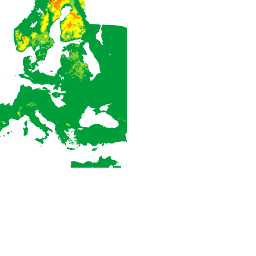ดัชนีละอองเกสรสากล (UPI) คืออะไร
ดัชนีละอองเกสรทั่วไป (UPI) ออกแบบมาเพื่อเสนอระดับที่สอดคล้องกันทั่วโลก สำหรับการเปรียบเทียบระดับละอองเกสรในพื้นที่ต่างๆ ดัชนีนี้ช่วยประเมิน ความเสี่ยงต่อการสัมผัสละอองเกสรตามปัจจัยต่างๆ สำหรับผู้ที่แพ้หรือ ไวต่อละอองเกสร โดยอิงตามโมเดลหลายชั้น ซึ่งเป็นการแสดงข้อมูลระดับละอองเกสรที่พิจารณาความเข้มข้นต่อโมเดลพืช ดัชนีละอองเกสรในท้องถิ่น (LPI) ที่แตกต่างกันหลายรายการที่ใช้ทั่วโลก และความสามารถในการก่อภูมิแพ้ของละอองเกสรพืชประเภทต่างๆ เพื่อคาดการณ์จํานวนละอองเกสรต่อลูกบาศก์เมตร (ละอองเกสร/ม³) ต่อวัน
ปลายทาง heatmapTiles จะแสดงผลไทล์แผนที่ความหนาแน่นที่วางซ้อนบนแผนที่ฐานได้
ไทล์ฮีตแมปจะแสดง UPI ทั่วโลกสำหรับประเภทพืชที่กำหนด (TREE, GRASS หรือ WEED)
ดัชนีประกอบด้วย 6 หมวดหมู่ ได้แก่
| ค่า | สี | คำอธิบาย |
|---|---|---|
| 0 | ไม่มี | |
| 1 | ต่ำมาก | |
| 2 | ต่ำ | |
| 3 | ปานกลาง | |
| 4 | สูง | |
| 5 | สูงมาก |
แต่ละหมวดหมู่จะอิงตามระดับความเข้มข้นของละอองเกสรในพื้นที่หนึ่งๆ และผลกระทบต่อความรุนแรงของอาการแพ้ที่มักเกิดขึ้น ซึ่งจะแสดงระดับละอองเกสรอย่างครอบคลุม การผสานรวม UPI ช่วยให้ผู้ใช้เปรียบเทียบและประเมินสภาพละอองเกสรในสถานที่ต่างๆ ได้
ตัวอย่างเช่น แผ่นฮีตแมปต่อไปนี้แสดงTREEระดับละอองเกสรตั้งแต่ต่ำมากไปจนถึงสูงมาก

พืชที่รองรับ
API ละอองเกสรรองรับพืช 3 ประเภท ได้แก่ หญ้า วัชพืช และต้นไม้ เนื่องจากความพร้อมใช้งานของพืชขึ้นอยู่กับการวัดและรายงานแหล่งข้อมูลจริง ข้อมูลพืชของ Pollen API จึงอาจแตกต่างกันไปในแต่ละสถานที่
รายการต่อไปนี้แสดงรหัสพืชที่รองรับและข้อมูลเมตาของรหัสเหล่านั้น
| รหัสโรงงาน | ชื่อที่แสดง | ประเภท |
|---|---|---|
ALDER |
Alder | ต้นไม้ |
ASH |
เทาแอช | ต้นไม้ |
BIRCH |
เบิร์ช | ต้นไม้ |
COTTONWOOD |
Cottonwood | ต้นไม้ |
ELM |
Elm | ต้นไม้ |
MAPLE |
เมเปิล | ต้นไม้ |
OLIVE |
สีเขียวมะกอก | ต้นไม้ |
JUNIPER |
Juniper | ต้นไม้ |
OAK |
โอ๊ค | ต้นไม้ |
PINE |
สน | ต้นไม้ |
CYPRESS_PINE |
สนไซเปรส | ต้นไม้ |
HAZEL |
น้ำตาลเฮเซล | ต้นไม้ |
GRAMINALES |
หญ้า | หญ้า |
JAPANESE_CEDAR |
ต้นซีดาร์ญี่ปุ่น | ต้นไม้ |
JAPANESE_CYPRESS |
ต้นสนไซเปรสญี่ปุ่น | ต้นไม้ |
RAGWEED |
แร็กวีด | วัชพืช |
MUGWORT |
จิงจูฉ่าย | วัชพืช |

